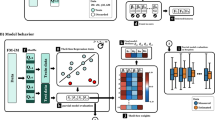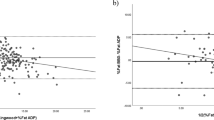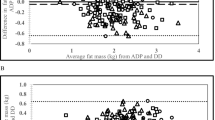Abstract
Introduction:
Air-displacement plethysmography (ADP) was developed as a noninvasive tool to assess body composition, i.e., the proportion of fat mass (%FM) and lean body mass. The results of previous studies comparing ADP with labeled water dilution in infants and with chemical analysis in phantoms have validated the ADP approach indirectly. We assessed the precision and accuracy of measurements of %FM proportions in live animals, using ADP in comparison with biochemical analyses.
Methods:
Three groups of 12 piglets each underwent four consecutive body composition assessments at 2, 7, and 21 d and were euthanized to determine whole-body lipid content by direct chemical analysis.
Results:
The average body weights were 1,490, 2,210, and 5,610 g at d2, d7, and d21, respectively. The mean %FM values determined by biochemical analysis and ADP were 8.63 ± 4.08% and 8.01 ± 4.03%, respectively. Linear regression and Bland–Altman analyses indicated good agreement for %FM. The root mean square coefficient of variation (RMS-CV) for ADP was 17.9%, with a better precision in the higher fat mass range.
Discussion:
Despite its relatively poor precision in the low range of %FM, ADP measures fat mass with reasonable precision and accuracy in the range of body weight encountered in low-birth-weight infants.
Similar content being viewed by others
Log in or create a free account to read this content
Gain free access to this article, as well as selected content from this journal and more on nature.com
or
References
Barker DJ . The developmental origins of adult disease. J Am Coll Nutr 2004;23:Suppl 6:588S–95S.
Rolland-Cachera MF, Deheeger M, Akrout M, Bellisle F . Influence of macronutrients on adiposity development: a follow up study of nutrition and growth from 10 months to 8 years of age. Int J Obes Relat Metab Disord 1995;19:573–8.
Ellis KJ . Evaluation of body composition in neonates and infants. Semin Fetal Neonatal Med 2007;12:87–91.
Koo WW, Walters JC, Hockman EM . Body composition in neonates: relationship between measured and derived anthropometry with dual-energy X-ray absorptiometry measurements. Pediatr Res 2004;56:694–700.
Shypailo RJ, Butte NF, Ellis KJ . DXA: can it be used as a criterion reference for body fat measurements in children? Obesity (Silver Spring) 2008;16:457–62.
Blake GM, Naeem M, Boutros M . Comparison of effective dose to children and adults from dual X-ray absorptiometry examinations. Bone 2006;38:935–42.
Urlando A, Dempster P, Aitkens S . A new air displacement plethysmograph for the measurement of body composition in infants. Pediatr Res 2003;53:486–92.
Ellis KJ, Yao M, Shypailo RJ, Urlando A, Wong WW, Heird WC . Body-composition assessment in infancy: air-displacement plethysmography compared with a reference 4-compartment model. Am J Clin Nutr 2007;85:90–5.
Ma G, Yao M, Liu Y, et al. Validation of a new pediatric air-displacement plethysmograph for assessing body composition in infants. Am J Clin Nutr 2004;79:653–60.
Sainz RD, Urlando A . Evaluation of a new pediatric air-displacement plethysmograph for body-composition assessment by means of chemical analysis of bovine tissue phantoms. Am J Clin Nutr 2003;77:364–70.
Fomon SJ, Haschke F, Ziegler EE, Nelson SE . Body composition of reference children from birth to age 10 years. Am J Clin Nutr 1982;35:Suppl 5:1169–75.
Butte NF, Hopkinson JM, Wong WW, Smith EO, Ellis KJ . Body composition during the first 2 years of life: an updated reference. Pediatr Res 2000;47:578–85.
Puiman P, Stoll B . Animal models to study neonatal nutrition in humans. Curr Opin Clin Nutr Metab Care 2008;11:601–6.
Hull HR, Dinger MK, Knehans AW, Thompson DM, Fields DA . Impact of maternal body mass index on neonate birthweight and body composition. Am J Obstet Gynecol 2008;198:416.e1–6.
Giannì ML, Roggero P, Taroni F, Liotto N, Piemontese P, Mosca F . Adiposity in small for gestational age preterm infants assessed at term equivalent age. Arch Dis Child Fetal Neonatal Ed 2009;94:F368–72.
Polonovski C, Voyer M, Chaumeil JC, Courpotin C . [Nutrition et renutrition en pratique pédiatrique]. Nutrition and Nutritional Rehabilitation in Clinical Pediatric Practice. Paris, France: Expansion Scientifique Française, 1992:1–735.
Koo WW, Hammami M, Hockman EM . Validation of bone mass and body composition measurements in small subjects with pencil beam dual energy X-ray absorptiometry. J Am Coll Nutr 2004;23:79–84.
Sheng HP, Adolph AL, Smith EO, Garza C . Body volume and fat-free mass determinations by acoustic plethysmography. Pediatr Res 1988;24:85–9.
Mitchell AD . Validation of quantitative magnetic resonance body composition analysis for infants using piglet model. Pediatr Res 2011;69:330–5.
Shulman RJ . The piglet can be used to study the effects of parenteral and enteral nutrition on body composition. J Nutr 1993;123:Suppl 2:395–8.
Rudolph BC, Stahly TS, Cromwell GL . Estimation of body composition of neonatal pigs via deuterium oxide dilution: validation of technique. J Anim Sci 1988;66:53–61.
Kraybill HF, Goode ER, Robertson RS, Sloane HS . In vivo measurement of body fat and body water in swine. J Appl Physiol 1953;6:27–32.
Wachtel TL, McCahan GR Jr, Knox FS 3rd . Methods of preparing porcine skin for bioassay of thermal injury. Mil Med 1977;142:536–8.
DeRoth L, Bisaillon A . Determination of body surface area in neonatal swine. Lab Anim Sci 1979;29:249–50.
Kelley KW, Curtis SE, Marzan GT, Karara HM, Anderson CR . Body surface area of female swine. J Anim Sci 1973;36:927–30.
Guo SS, Chumlea WC . Tracking of body mass index in children in relation to overweight in adulthood. Am J Clin Nutr 1999;70:145S–148S.
Krause MF, Jäkel C, Haberstroh J, Schulte-Mönting J, Hoehn T . Functional residual capacity determines the effect of inhaled nitric oxide on intrapulmonary shunt and gas exchange in a piglet model of lung injury. Pediatr Crit Care Med 2001;2:82–7.
Proquitté H, Kusztrich A, Auwärter V, Pragst F, Wauer RR, Schmalisch G . Functional residual capacity measurement by heptafluoropropane in ventilated newborn lungs: in vitro and in vivo validation. Crit Care Med 2006;34:1789–95.
Kloareg M, Noblet J, van Milgen J . Deposition of dietary fatty acids, de novo synthesis and anatomical partitioning of fatty acids in finishing pigs. Br J Nutr 2007;97:35–44.
Bland JM, Altman DG . Statistical methods for assessing agreement between two methods of clinical measurement. Lancet 1986;1:307–10.
Acknowledgements
We are grateful to Alessandro Urlando and Manoj Raghuraman for their generous help in adapting equations for application in piglets. They are employees of Life Measurement Inc. (now part of COSMED), the manufacturer of the Pea Pod Instrument. We also thank C. Tréfeu and G. Savary for their expert technical assistance. We are grateful to all the staff involved in the care of the animals.
Author information
Authors and Affiliations
Corresponding author
Rights and permissions
About this article
Cite this article
Frondas-Chauty, A., Louveau, I., Le Huërou-Luron, I. et al. Air-displacement plethysmography for determining body composition in neonates: validation using live piglets. Pediatr Res 72, 26–31 (2012). https://doi.org/10.1038/pr.2012.35
Received:
Accepted:
Published:
Issue date:
DOI: https://doi.org/10.1038/pr.2012.35
This article is cited by
-
Body composition in preterm infants: a systematic review on measurement methods
Pediatric Research (2023)
-
Anthropometry-based prediction of body fat in infants from birth to 6 months: the Baby-bod study
European Journal of Clinical Nutrition (2021)
-
Air displacement plethysmography (pea pod) in full-term and pre-term infants: a comprehensive review of accuracy, reproducibility, and practical challenges
Maternal Health, Neonatology and Perinatology (2018)
-
Fat deposition deficiency is critical for the high mortality of pre-weanling newborn piglets
Journal of Animal Science and Biotechnology (2018)



